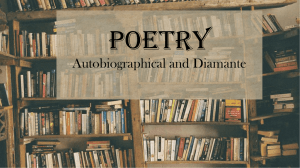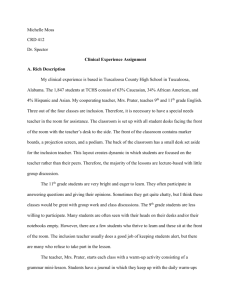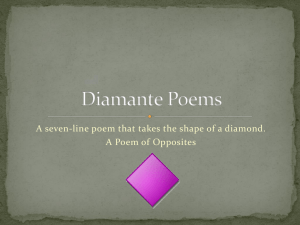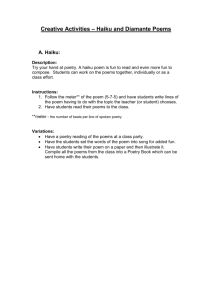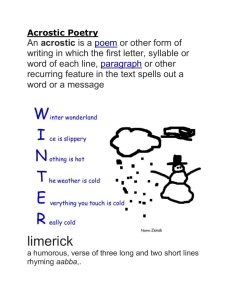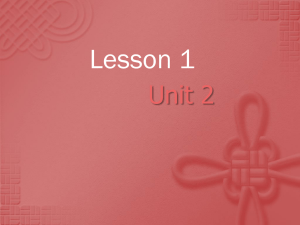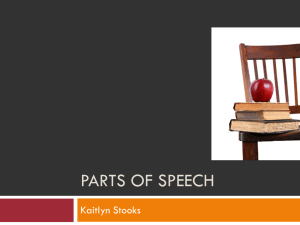Diamante Poems
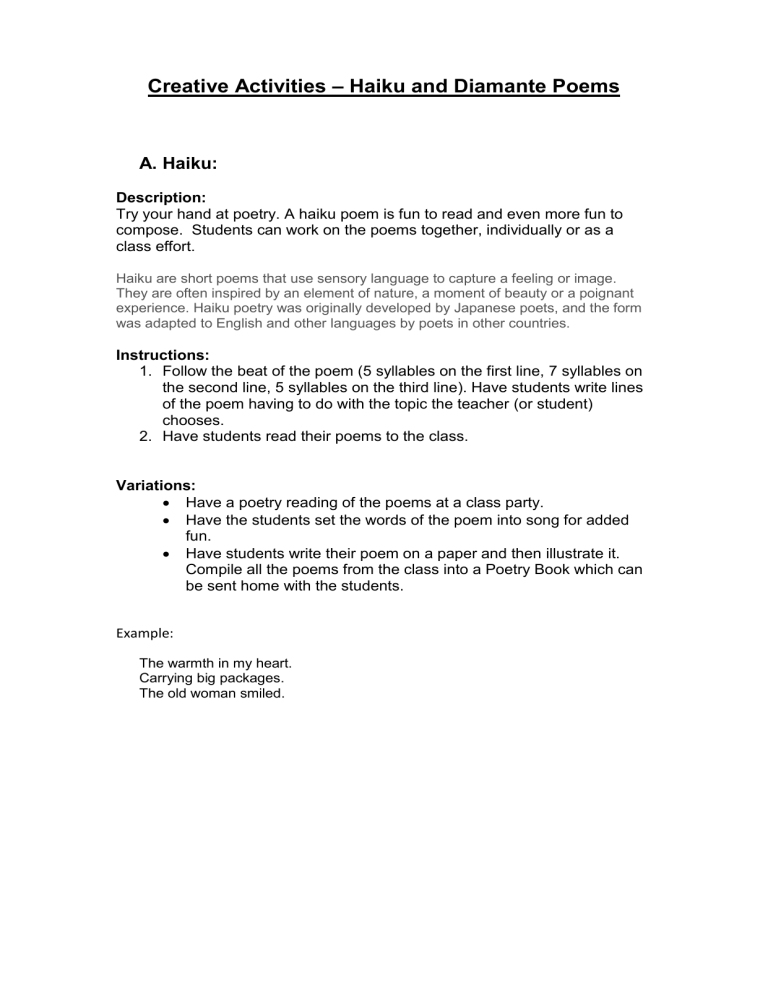
Creative Activities
– Haiku and Diamante Poems
A. Haiku:
Description:
Try your hand at poetry. A haiku poem is fun to read and even more fun to compose. Students can work on the poems together, individually or as a class effort.
Haiku are short poems that use sensory language to capture a feeling or image.
They are often inspired by an element of nature, a moment of beauty or a poignant experience. Haiku poetry was originally developed by Japanese poets, and the form was adapted to English and other languages by poets in other countries.
Instructions:
1. Follow the beat of the poem (5 syllables on the first line, 7 syllables on the second line, 5 syllables on the third line). Have students write lines of the poem having to do with the topic the teacher (or student) chooses.
2. Have students read their poems to the class.
Variations:
Have a poetry reading of the poems at a class party.
Have the students set the words of the poem into song for added fun.
Have students write their poem on a paper and then illustrate it.
Compile all the poems from the class into a Poetry Book which can be sent home with the students.
Example:
The warmth in my heart.
Carrying big packages.
The old woman smiled.
B. Diamante Poems:
WHAT IS A DIAMANTE?
A diamante – pronounced dee-uh-MAHN-tay – is an unrhymed seven-line poem. The beginning and ending lines are the shortest, while the lines in the middle are longer, giving diamante poems a diamond shape. “Diamante” is the Italian word for diamond, so this poetic form is named for this diamond shape.
Believe it or not, the diamante was invented just 40 years ago. It was created by an
American poet named Iris McClellan Tiedt in 1969, and has become very popular in schools.
Also known as a “diamond poem” because of its shape, there are two different types of diamantes; synonym diamantes and antonym diamantes.
THE RULES OF A DIAMANTE
There are just a few rules to writing a diamante:
1.
Diamantes are seven lines long.
2.
The first and last lines have just one word.
The second and sixth lines have two words.
The third and fifth lines have three words.
And the fourth line has four words.
3.
Lines 1, 4, and 7 have nouns.
Lines 2 and 6 have adjectives.
Lines 3 and 5 have verbs.
Here’s an easy way to visualize all three rules:
Noun
Adjective, Adjective
Verb, Verb, Verb
Noun, Noun, Noun, Noun
Verb, Verb, Verb
Adjective, Adjective
Noun
In a synonym diamante, the nouns at the beginning and end are two words that mean basically the same thing. In an antonym diamante, the two nouns are opposites. Here are a couple of examples:
SYNONYM DIAMANTE
In this diamante, the words “Pesach” and “Passover” mean the same thing, so they are synonyms.
Pesach
Busy, exciting
Cleaning, cooking, preparing
Matzah, wine, eggs, afikoman
Eating, visiting, learning
Beautiful, special
Passover
ANTONYM DIAMANTE
In this diamante, you might say that the words “Vashti” and “Esther” are opposites, or
“antonyms,” so this is an antonym diamante.
Vashti
Wicked, mean
Laughing, hurting, gloating
Crown, wine, nuts, crown
Praying, hoping, crying
Good, caring
Esther
GETTING STARTED
To start writing a diamante, you first need to decide what thing you want to write about.
The reason you want to pick a thing is that your first and last lines need to be nouns. In other words, your diamante will be about a noun, such as a “pencil” or a “pizza,” rather than about a verb, such as “jump” or an adjective like “smelly.” An easy thing to write about is something you like or something you see around you.
Next, you’ll want to decide whether you want to write a synonym diamante or an antonym diamante. If you want to write a synonym diamante, you’ll want to select another word that means the same thing as your subject. If you are going to write an antonym diamante, choose a word that is its opposite.
Once you’ve chosen your two nouns, take a piece of paper and brainstorm as many words as you can that have to do with each of them. For example, make one column for each word and write down everything you can think of. You’ll want adjectives (descriptive words), verbs (action words), and even more nouns. For an advanced class, your lists should look something like this:
Sun Moon
Hot
Yellow
Fiery
Day
Light
Blinding
Exploding
Distant
Cold
Silver
Night
Still
Orbiting
Shining
Beautiful
Crescent
Finally, you’ll want to arrange your diamante, putting the synonyms or antonyms at the top and bottom, the adjectives next, on lines 2 and 6, the verbs after that on lines 3 and
5, and lastly your additional nouns on the middle line.
In the top half of the poem – lines 2 and 3 – your adjectives and verbs should be ones from your first brainstorming column – words that have to do with line 1, like this:
Sun
Fiery, Yellow
Burning, Blinding, Exploding
In the bottom half of the poem – lines 5 and 6 – your adjectives and verbs should be related to the noun on line 7, like this:
Shining, Orbiting, Reflecting
Cold, Silver
Moon
On line 4, the line in the middle of the poem, the first two nouns should be related to the noun on line 1, and the last two nouns should be related to the noun on line 7, like this:
Flame, Light, Night, Crescent
When you put everything together, you’ll end up with something like this:
Sun
Fiery, Yellow
Burning, Blinding, Exploding
Flame, Light, Night, Crescent
Shining, Orbiting, Reflecting
Cold, Silver
Moon
For a lower level, it could look like this:
Sun Moon
Hot
Yellow
Day
Light
Baking
Glowing
Burning
Cold
White
Night light
Smiling
Shining
Reflecting
Don’t worry if you have more words than you need. It’s better to have too many words to choose from than not enough.
Again, you’ll want to arrange your diamante, putting the synonyms or antonyms at the top and bottom, the adjectives next, on lines 2 and 6, the verbs after that on lines 3 and 5, and lastly your additional nouns on the middle line.
In the top half of the poem – lines 2 and 3 – your adjectives and verbs should be ones from your first brainstorming column – words that have to do with line 1, like this:
Sun
Hot, Yellow
Burning, Baking, Glowing
In the bottom half of the poem – lines 5 and 6 – your adjectives and verbs should be related to the noun on line 7, like this:
Shining, Smiling, Reflecting
Cold, White
Moon
On line 4, the line in the middle of the poem, the first two nouns should be related to the noun on line 1, and the last two nouns should be related to the noun on line 7, like this:
Day, Light, Night, Light
When you put everything together, you’ll end up with something like this:
Sun
Hot, Yellow
Burning, Baking, Glowing
Day, Light, Night, Light
Shining, Smiling, Reflecting
Cold, White
Moon
THINGS TO REMEMBER
As you begin writing your own diamantes, here are the important things to remember:
Diamantes can be about anything.
They are 7 lines long.
The word count is simple: 1, 2, 3, 4, 3, 2, 1
Your lines should have: noun, adjectives, verbs, nouns, verbs, adjectives, noun.
Try to “center” your poem on the page to give it a diamond shape
Most importantly, have fun!
